Temporary & permanent culture finds a place in Middlesbrough
The 2025 Middlesbrough Art Week took place across the city,
with solo & group exhibitions popping up in empty shops & unexpected
places. At the same time, the organisation behind it all, The Auxiliary Project
Space, prepared to open their impressive new studio complex HQ, renovated
by De Matos Ryan Architects. Will Jennings visited to find out how both temporal
& permanence can bring the city a rich cultural infrastructure.
Culture as a pop-up, momentary event is now a common urban
experience. Whether a temporary pavilion, street performer, or inhabiting an
empty shop, temporal projects have become a critical part of the art ecosystem.
Obviously, permanence and a more traditional bricks and mortar approach to rooted
culture is not going away, with new or expanded museums and galleries seemingly
announced daily across the world.
In Middlesbrough, a cultural organisation balances both, reaffirming its commitment to the city’s permanent cultural offer with a newly renovated and expanded exhibition and studio complex, while also covering the city with pop-up art for the annual Middlesbrough Art Week. The Auxillary Project Space was only founded nine years ago, originally as a self-funded sound art residency in a house in Stockton. Proving that culture happens across the country, and not just the larger cities, it has quickly grown to become an Arts Council National Portfolio Organisation supporting over 100 artists annually, 25 of whom will soon have generous and affordable studios in their new HQ designed by De Matos Ryan Architects, an overhaul of an existing early 1900s industrial building close to completion when this year’s Art Week took place.
![]()
The Auxillary Project, and its energetic team, are also the lead players in the annual Middlesbrough Art Week, a diverse and experimental festival of culture that takes over several city centre shops as temporal spaces of exhibition. Consisting of 11 separate solo and group exhibitions, the overarching theme of this year’s edition is In All Possible Worlds, “[daring] to imagine a future shaped by creativity, resilience, and hope.”
Such a broad and somewhat meaningless title (does any culture claim to seek the opposite to these aims?) is needed to umbrella a real mix of ideas and approaches. This is not necessarily a bad thing, the joy of such a festival being dispersed across an urban environment is that each space acts singularly as a pleasurable puncture into the streetscape of consumerism. This is certainly the case with a solo presentation by Andrea Hasler, supported by maternal-supporting arts organisation Motherother. Suitably, Hassler’s installation – formed of three separate works – speaks to motherhood and its intersection with the state. Do not, however, expect saccharine lullabies and soothing scenes, the raw concrete former-shop is occupied by what appears as a lump of fleshy meat, mutated and broken figures – including legs modelled from the artist’s own daughter – in what appears as a horrorscape.
![]()
Motherhood is all about the body, and Hassler’s work does not shy away from this, with that body not only the carrier of and provider for a child, but also a permeable barrier – whether within the uterus or between mother and society. A meaty pattern is printed across material usually used for luxury car upholstery, speaks to that surface of presentation and display coexisting with consumerism and function. A machine-like arrangement of blinged-up teats and tubing hang from gold chains over the distorted figures, the body here having autonomy removed and regarded as a disposable machine of provision.
![]()
Another solo exhibition that arrested passing shoppers was by guerrilla artist and subvertiser Darren Cullen. Widely known under his artistic moniker Spelling Mistakes Cost Lives for inserting darkly satirical and politically charged faux adverts into bus stops and tube trains, forcing readers to step into an uncanny period of questioning truth, values, and capitalism. Here, he presents an expanded version of his oeuvre, turning an entire shop into an estate agents specialising in properties on occupied Palestinian land.
It is a detailed, complicated, and viciously angry installation that even extends outside of the unit – above the door, the bloody body of a white dove is pierced upon pigeon spikes. Designed not to be entered but read from the street, a window display shows properties for sale in the West Bank with critically arch particulars: “Biblically appointed property”, “Planning permission to extend into neighbour’s garden”, and “Security by Israeli troops / heavily armed teens”.
![]()
![]()
The unit is a gesamtkunstwerk of genocidal terror: A JCB appears paused in mid-destrction, revealing a large image of Gaza destroyed; a chart maps occupied sites across the West Bank; a gun on the wall is joined by the text “FREE ASSAULT RIFLE WITH EVERY NEW HOME”. The estate agent’s desk has a Newton’s cradle formed of skulls, a framed photo of Banjamin Netenyahu, Kier Starmer, and Donald Trump, and a flatscreen monitor showing a devastating image Gaza City that reads like Somme mud. Not a subtle work, but cleverly playing with the context of an arts festival that interrupts the fabric and expectation of a city space of consumption.
Such temporal reuse of otherwise empty, and often rather miserable and stripped-our, commercial units isn’t always as successful as Cullen carries out. His work takes over the unit entirely, transforming it, whereas with a more traditional arts presentation it can be difficult to turn large, dimly lit, long-shut commercial spaces into compelling and inviting displays of art. Nearby, what was once a cavernous TK Maxx is used by Art Week to present a series of different, and disconnected works. Individually, some are very good but spread out around the perimeter with large gaps between works it looks temporary in a way that Cullens did not, and does not collectively have the visual draw of Hasler’s offer.
![]()
As a mix of works without a singular curator, it shows both the problem with such a broad and general festival theme and how while it seems empty shops are easily adapted for exhibition use, they can also look more empty shop than exhibition without a strong curatorual hand and a busy enough hang with compelling works. One great solution for such large, dark spaces can be film works, and one in this space is a standout piece for both its content and how it fills the void. Machine Learning, by Mike Stubbs in collaboration with Roland Denning, is an excellent audio-visual poetic journey into the human connection with machines, from Middlesbrough roots of the Industrial Revolution through to mineral extraction and globalised capitalism of today.
An even larger unit – once a B&M store – is the counter example, with two distinct and superbly curated presentations packed with excellent artworks from the established and emerging regional practitioners. It is still an empty, paired back shop, and does not pretend to be a white wall gallery, but here the space is well considered, works carefully placed in relation to the room and one another, and altogether reading as a coherent and compelling exhibitions.
![]()
![]()
The main body of the space is occupied by five artists selected for the annual North East Open Call, mid-career artists working across a range of media. Erin Dickson’s excellent, witty, and empathetic study of Harton Moor housing estate through a 3D graphic architectural model, first presented at FACT in Liverpool, is a joy. Kitty McKay’s absurdist assembleges formed of urban infrastructure – metro seats, transport ironwork, convex mirrors, newspaper stands – are sublime urban extractions inviting scrutiny and distorted readings of the constructed landscapes we inhabit. Jonathan West’s wide painting of patterns and colourful graphic distortion is wondrously refracted through one of Iris Ollier’s lens-based sculptures suspended from the ceiling, a precarious pool of water sucking in and reforming the surrounding works.
![]()
In two wings to the main space, formed with cheap chipboard to create a sense of separation and difference while also offering respite from the ubiquitous surfaces of breezeblock and concrete, works by ten fine art graduates from local universities are presented in a busy, exciting hang. The exhibition marks the culmination of a three month residency, artist fee, and support for materials and travel each received through the New Graduate Award, with the mix of works a joy. A triptych of drawings by Elliot Kitchener of archi-sculptural forms sited somewhere between Henry Moore and Riccardo Bofill are wonderful.
![]()
Carl Truscott’s large grid of mobile phone screens printed with abstracted imagery invites slower looking at a surface we swipe relentlessly with fingers and eyes. While a spare arrangement of concrete fragments from Faye Magkanari, accompanied by a moving image work of Athens from above, is a careful extraction of urban form into gallery setting. The main joy from the B&M exhibitions is not just that each show is so well measured and curated individually, but there are sightlines, visual connections, and representation of career progression between the emerging New Graduate cohort and the five more established artists showing.
![]()
![]()
Other works dotted around town carry interest, though often individually rather than coherently in concert. Another high street space contains two excellent works. Slow Doom Scroll by Simon Poulter shows an extract of his long-running daily exercise of painting a scene from ongoing news in small, panoramic watercolour. There is a transmogrification in turning scenes of devastation and danger into a medium normally associated with the pastoral, twee, and picturesque, with such a shift asking the viewer to consider the aesthetics of conflict, mediation, and representation.
![]()
![]()
Alongside, And where now? is a film by Ukranian Svitlana Dovbush, a haunting and moving depiction of wartime landscapes in the eastern side of the artist’s country, damaged, ruptured, and reshaped by invasion and defence. It is not a documentary, so much as a poetic reflection. There are some connection between the two projects, but it seems that perhaps this is by accident more than curation – with no curatorial statement, title, or theme for the space, the visitor is left to draw their own conclusions, which may work for some, but in such a situation of presenting art in non-art spaces, and by virtue largely to a non-art audien
The Auxiliary Project is overseen by a small and highly energised team, led by Liam Slevin, Anna Byrne, and Edel O’Reilly, who also oversee an Art Week that is an extremely collaborative project involving several programme collaborators. As wide and complicated as Art Week is (including venues that had to change at the last moment for unforeseen circumstances) it’s small compared to their main project, a renovation and expansion of their Auxiliary HQ.
![]()
![]()
De Matos Ryan Architects were contracted for the job or making their much-loved but somewhat tired studio building suitable for makers to concentrate on their work in safety, with services, and without leaks or the cold. Their inventive approach, commonly used outside of the UK but less-so here, was to externally insulate the building, freeing up money and time for major internal rejigging. The new space offers a variety of 25 affordable studios which are now used for all kinds of craft from metalwork sculpting to painting. A new gallery space is opened up, an events space – incorporating a corrugated green material recognisable from the building’s previous life – offers a platform for non-visual arts as well as a for-hire opportunity to raise funds, while a newly inserted mezzanine offers loose space that as of yet has no function but surely will evolve to become central to the creative community.
It is exciting and hopefully offers Auxiliary a secure and strong base not only to support the region’s community of makers, but from which to plot and plan future Art Weeks. There is something fascinating about the alternative approaches of permanence and temporal culture, each landing and working with the local place in different ways. As the Auxiliary team surely know, it can be complicated and extremely tiring to operate in both modes, but ultimately reach different audiences in different ways.
Imagery supported by MPB - the right way to buy, trade and sell camera gear.
More information on MPB can be found here.
In Middlesbrough, a cultural organisation balances both, reaffirming its commitment to the city’s permanent cultural offer with a newly renovated and expanded exhibition and studio complex, while also covering the city with pop-up art for the annual Middlesbrough Art Week. The Auxillary Project Space was only founded nine years ago, originally as a self-funded sound art residency in a house in Stockton. Proving that culture happens across the country, and not just the larger cities, it has quickly grown to become an Arts Council National Portfolio Organisation supporting over 100 artists annually, 25 of whom will soon have generous and affordable studios in their new HQ designed by De Matos Ryan Architects, an overhaul of an existing early 1900s industrial building close to completion when this year’s Art Week took place.

The Auxillary Project, and its energetic team, are also the lead players in the annual Middlesbrough Art Week, a diverse and experimental festival of culture that takes over several city centre shops as temporal spaces of exhibition. Consisting of 11 separate solo and group exhibitions, the overarching theme of this year’s edition is In All Possible Worlds, “[daring] to imagine a future shaped by creativity, resilience, and hope.”
Such a broad and somewhat meaningless title (does any culture claim to seek the opposite to these aims?) is needed to umbrella a real mix of ideas and approaches. This is not necessarily a bad thing, the joy of such a festival being dispersed across an urban environment is that each space acts singularly as a pleasurable puncture into the streetscape of consumerism. This is certainly the case with a solo presentation by Andrea Hasler, supported by maternal-supporting arts organisation Motherother. Suitably, Hassler’s installation – formed of three separate works – speaks to motherhood and its intersection with the state. Do not, however, expect saccharine lullabies and soothing scenes, the raw concrete former-shop is occupied by what appears as a lump of fleshy meat, mutated and broken figures – including legs modelled from the artist’s own daughter – in what appears as a horrorscape.

Motherhood is all about the body, and Hassler’s work does not shy away from this, with that body not only the carrier of and provider for a child, but also a permeable barrier – whether within the uterus or between mother and society. A meaty pattern is printed across material usually used for luxury car upholstery, speaks to that surface of presentation and display coexisting with consumerism and function. A machine-like arrangement of blinged-up teats and tubing hang from gold chains over the distorted figures, the body here having autonomy removed and regarded as a disposable machine of provision.
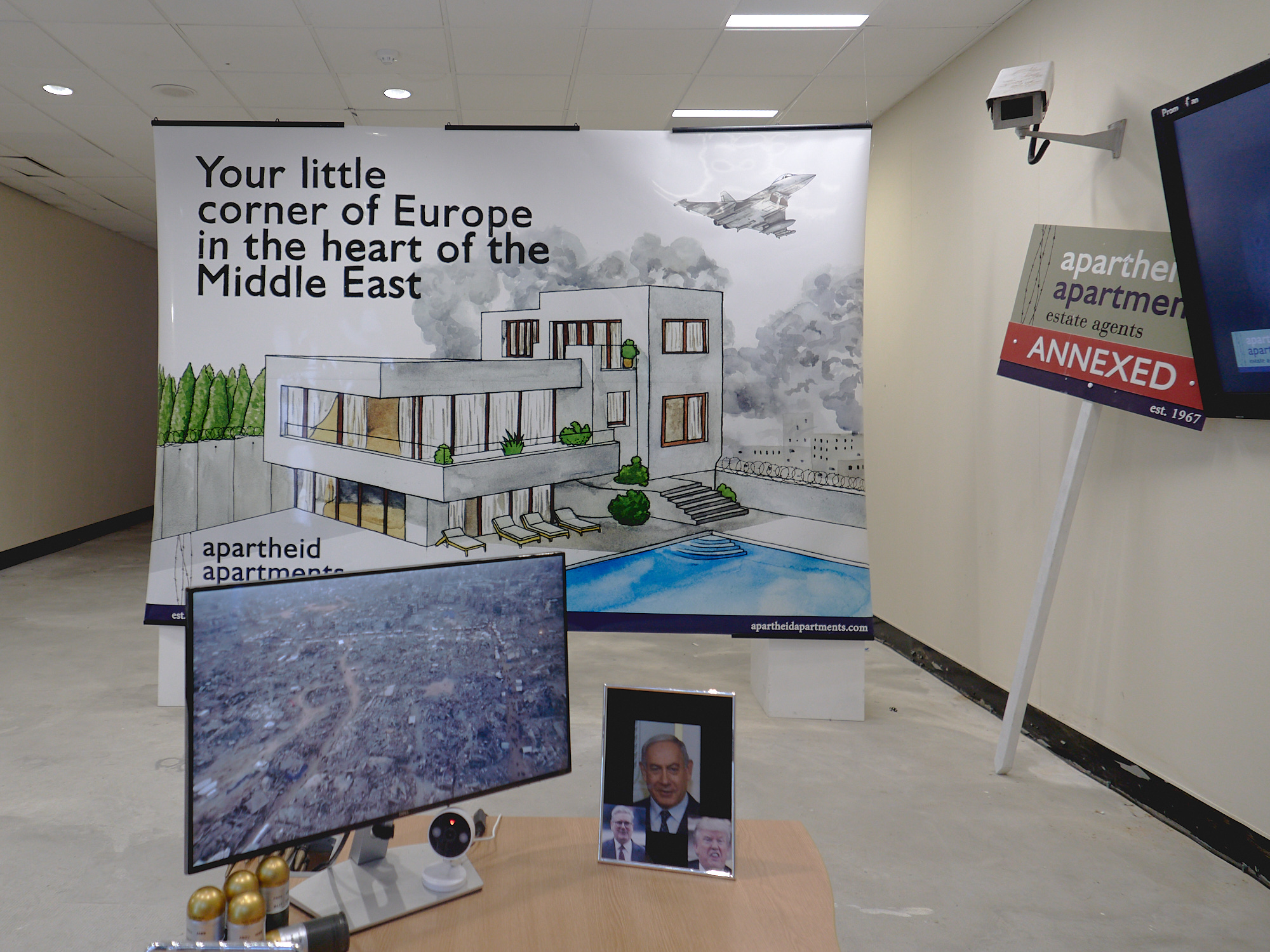
Another solo exhibition that arrested passing shoppers was by guerrilla artist and subvertiser Darren Cullen. Widely known under his artistic moniker Spelling Mistakes Cost Lives for inserting darkly satirical and politically charged faux adverts into bus stops and tube trains, forcing readers to step into an uncanny period of questioning truth, values, and capitalism. Here, he presents an expanded version of his oeuvre, turning an entire shop into an estate agents specialising in properties on occupied Palestinian land.
It is a detailed, complicated, and viciously angry installation that even extends outside of the unit – above the door, the bloody body of a white dove is pierced upon pigeon spikes. Designed not to be entered but read from the street, a window display shows properties for sale in the West Bank with critically arch particulars: “Biblically appointed property”, “Planning permission to extend into neighbour’s garden”, and “Security by Israeli troops / heavily armed teens”.

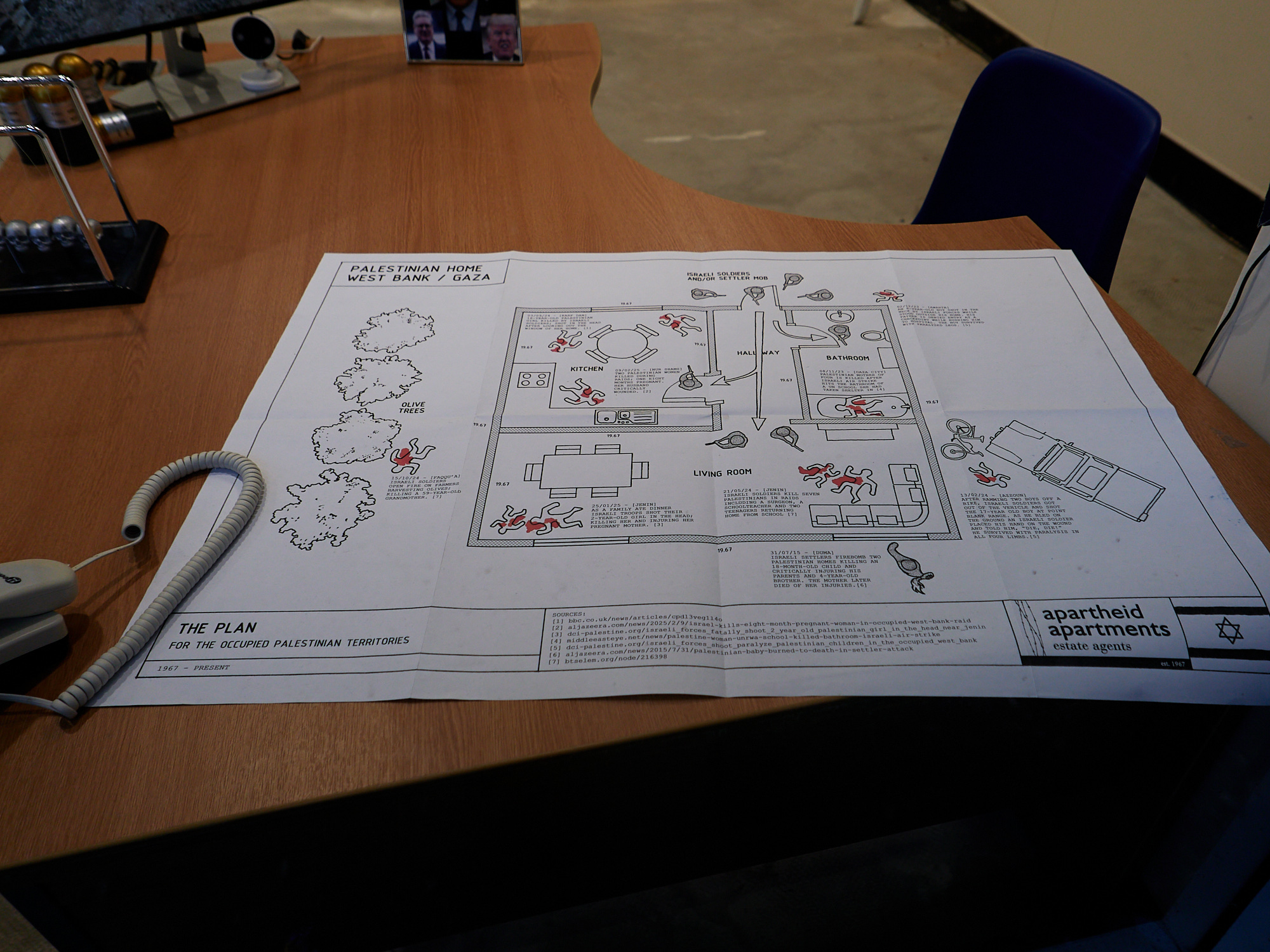
The unit is a gesamtkunstwerk of genocidal terror: A JCB appears paused in mid-destrction, revealing a large image of Gaza destroyed; a chart maps occupied sites across the West Bank; a gun on the wall is joined by the text “FREE ASSAULT RIFLE WITH EVERY NEW HOME”. The estate agent’s desk has a Newton’s cradle formed of skulls, a framed photo of Banjamin Netenyahu, Kier Starmer, and Donald Trump, and a flatscreen monitor showing a devastating image Gaza City that reads like Somme mud. Not a subtle work, but cleverly playing with the context of an arts festival that interrupts the fabric and expectation of a city space of consumption.
Such temporal reuse of otherwise empty, and often rather miserable and stripped-our, commercial units isn’t always as successful as Cullen carries out. His work takes over the unit entirely, transforming it, whereas with a more traditional arts presentation it can be difficult to turn large, dimly lit, long-shut commercial spaces into compelling and inviting displays of art. Nearby, what was once a cavernous TK Maxx is used by Art Week to present a series of different, and disconnected works. Individually, some are very good but spread out around the perimeter with large gaps between works it looks temporary in a way that Cullens did not, and does not collectively have the visual draw of Hasler’s offer.
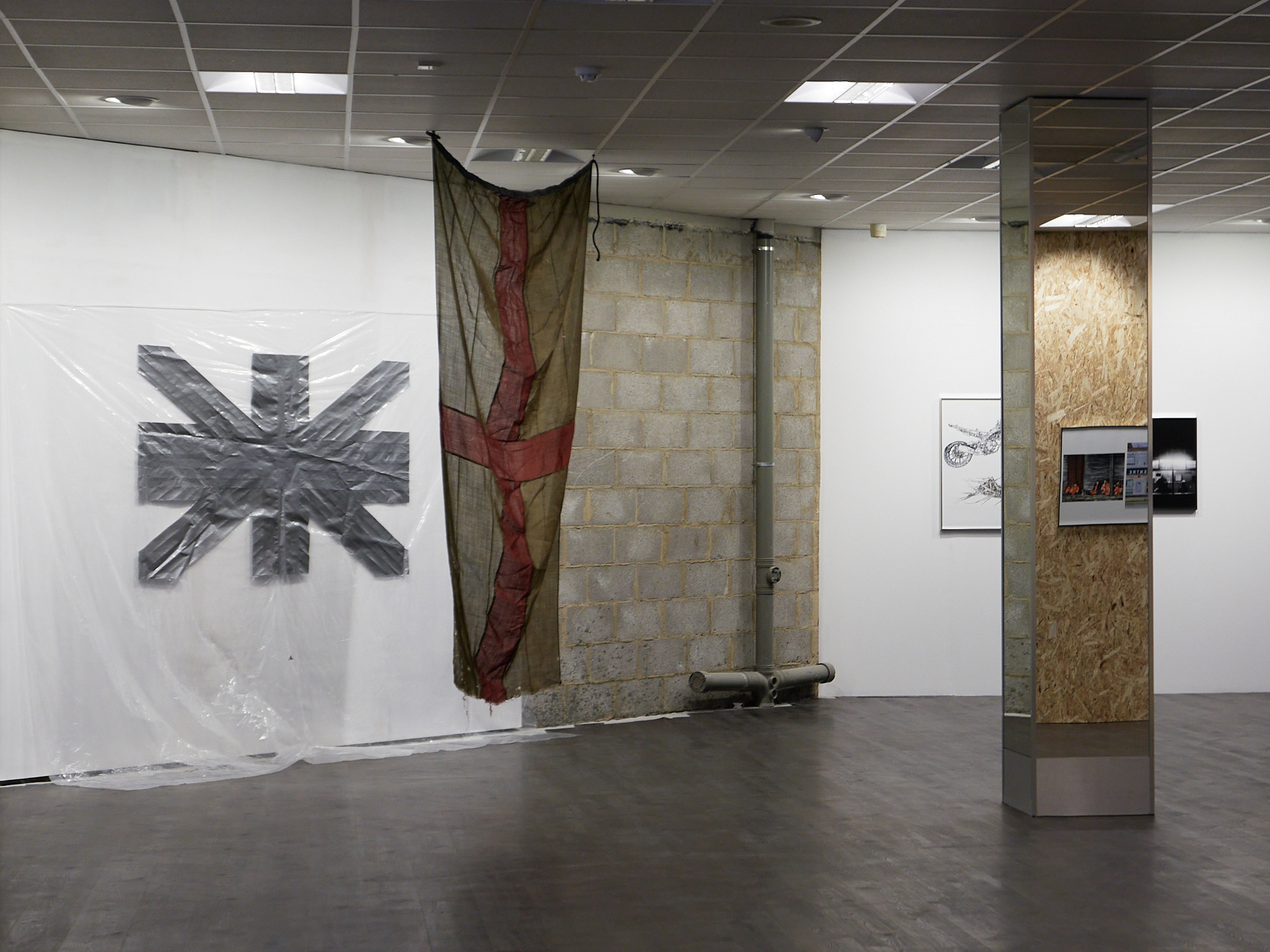
As a mix of works without a singular curator, it shows both the problem with such a broad and general festival theme and how while it seems empty shops are easily adapted for exhibition use, they can also look more empty shop than exhibition without a strong curatorual hand and a busy enough hang with compelling works. One great solution for such large, dark spaces can be film works, and one in this space is a standout piece for both its content and how it fills the void. Machine Learning, by Mike Stubbs in collaboration with Roland Denning, is an excellent audio-visual poetic journey into the human connection with machines, from Middlesbrough roots of the Industrial Revolution through to mineral extraction and globalised capitalism of today.
An even larger unit – once a B&M store – is the counter example, with two distinct and superbly curated presentations packed with excellent artworks from the established and emerging regional practitioners. It is still an empty, paired back shop, and does not pretend to be a white wall gallery, but here the space is well considered, works carefully placed in relation to the room and one another, and altogether reading as a coherent and compelling exhibitions.
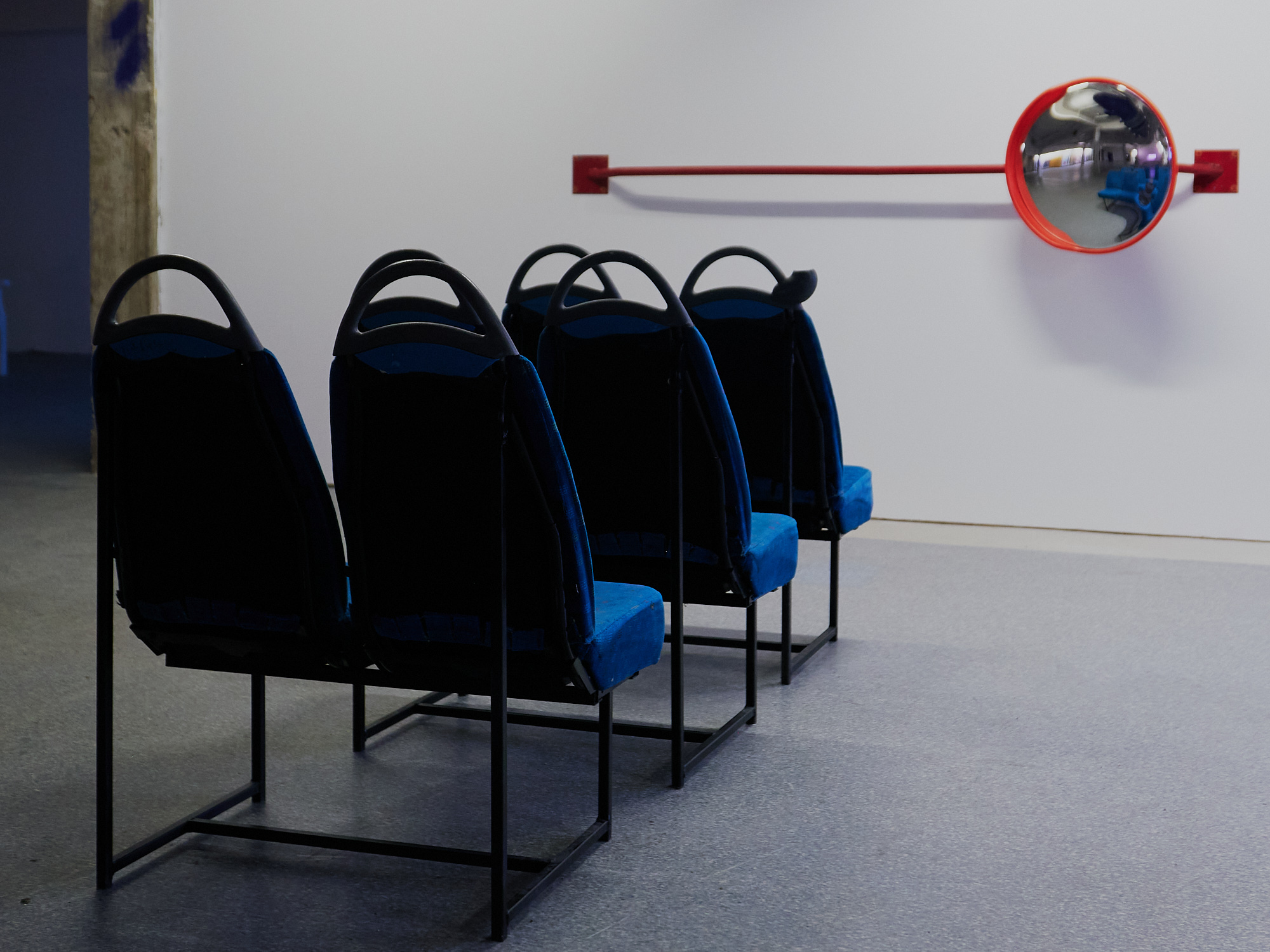

The main body of the space is occupied by five artists selected for the annual North East Open Call, mid-career artists working across a range of media. Erin Dickson’s excellent, witty, and empathetic study of Harton Moor housing estate through a 3D graphic architectural model, first presented at FACT in Liverpool, is a joy. Kitty McKay’s absurdist assembleges formed of urban infrastructure – metro seats, transport ironwork, convex mirrors, newspaper stands – are sublime urban extractions inviting scrutiny and distorted readings of the constructed landscapes we inhabit. Jonathan West’s wide painting of patterns and colourful graphic distortion is wondrously refracted through one of Iris Ollier’s lens-based sculptures suspended from the ceiling, a precarious pool of water sucking in and reforming the surrounding works.
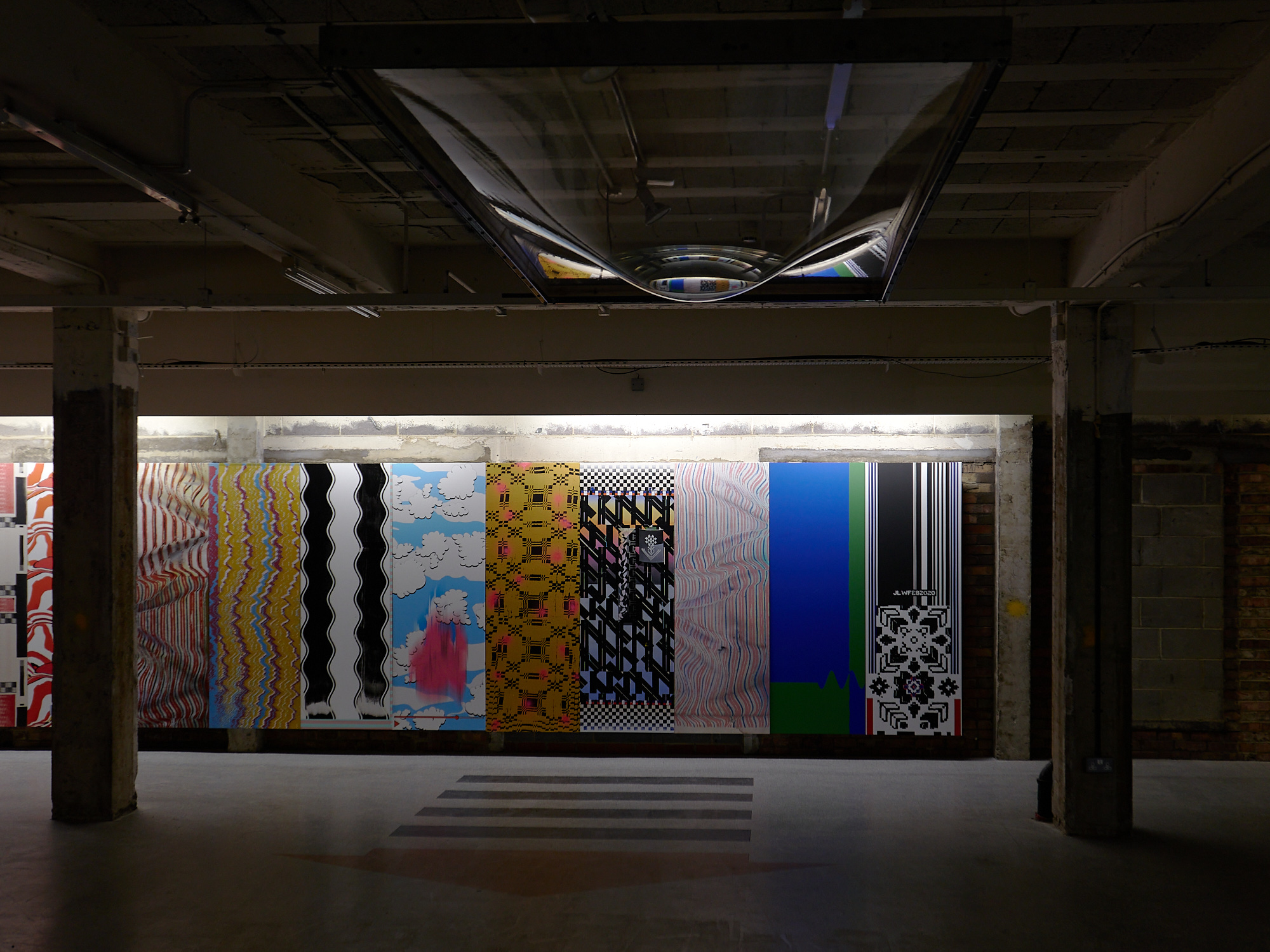
In two wings to the main space, formed with cheap chipboard to create a sense of separation and difference while also offering respite from the ubiquitous surfaces of breezeblock and concrete, works by ten fine art graduates from local universities are presented in a busy, exciting hang. The exhibition marks the culmination of a three month residency, artist fee, and support for materials and travel each received through the New Graduate Award, with the mix of works a joy. A triptych of drawings by Elliot Kitchener of archi-sculptural forms sited somewhere between Henry Moore and Riccardo Bofill are wonderful.

Carl Truscott’s large grid of mobile phone screens printed with abstracted imagery invites slower looking at a surface we swipe relentlessly with fingers and eyes. While a spare arrangement of concrete fragments from Faye Magkanari, accompanied by a moving image work of Athens from above, is a careful extraction of urban form into gallery setting. The main joy from the B&M exhibitions is not just that each show is so well measured and curated individually, but there are sightlines, visual connections, and representation of career progression between the emerging New Graduate cohort and the five more established artists showing.

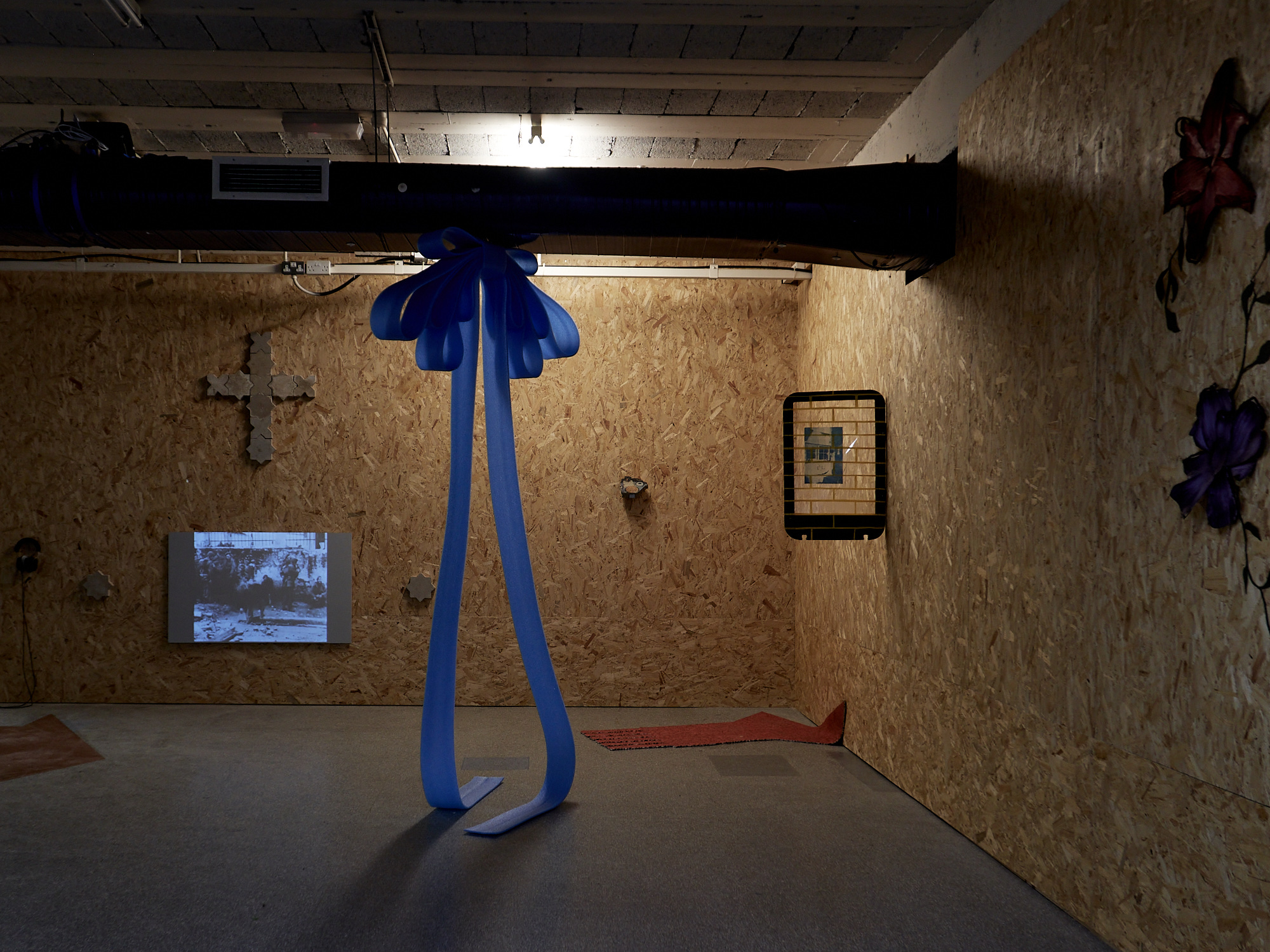
Other works dotted around town carry interest, though often individually rather than coherently in concert. Another high street space contains two excellent works. Slow Doom Scroll by Simon Poulter shows an extract of his long-running daily exercise of painting a scene from ongoing news in small, panoramic watercolour. There is a transmogrification in turning scenes of devastation and danger into a medium normally associated with the pastoral, twee, and picturesque, with such a shift asking the viewer to consider the aesthetics of conflict, mediation, and representation.
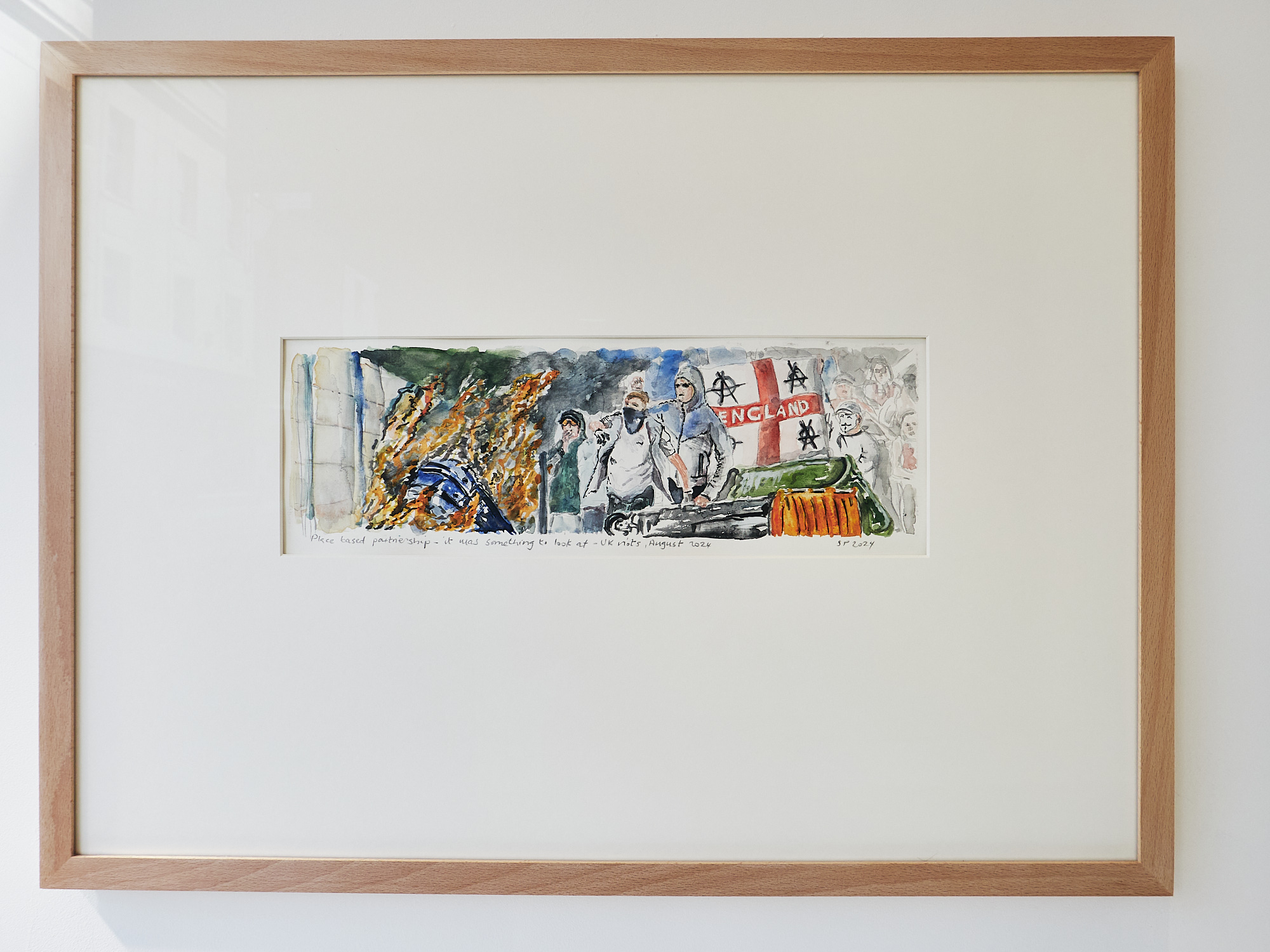
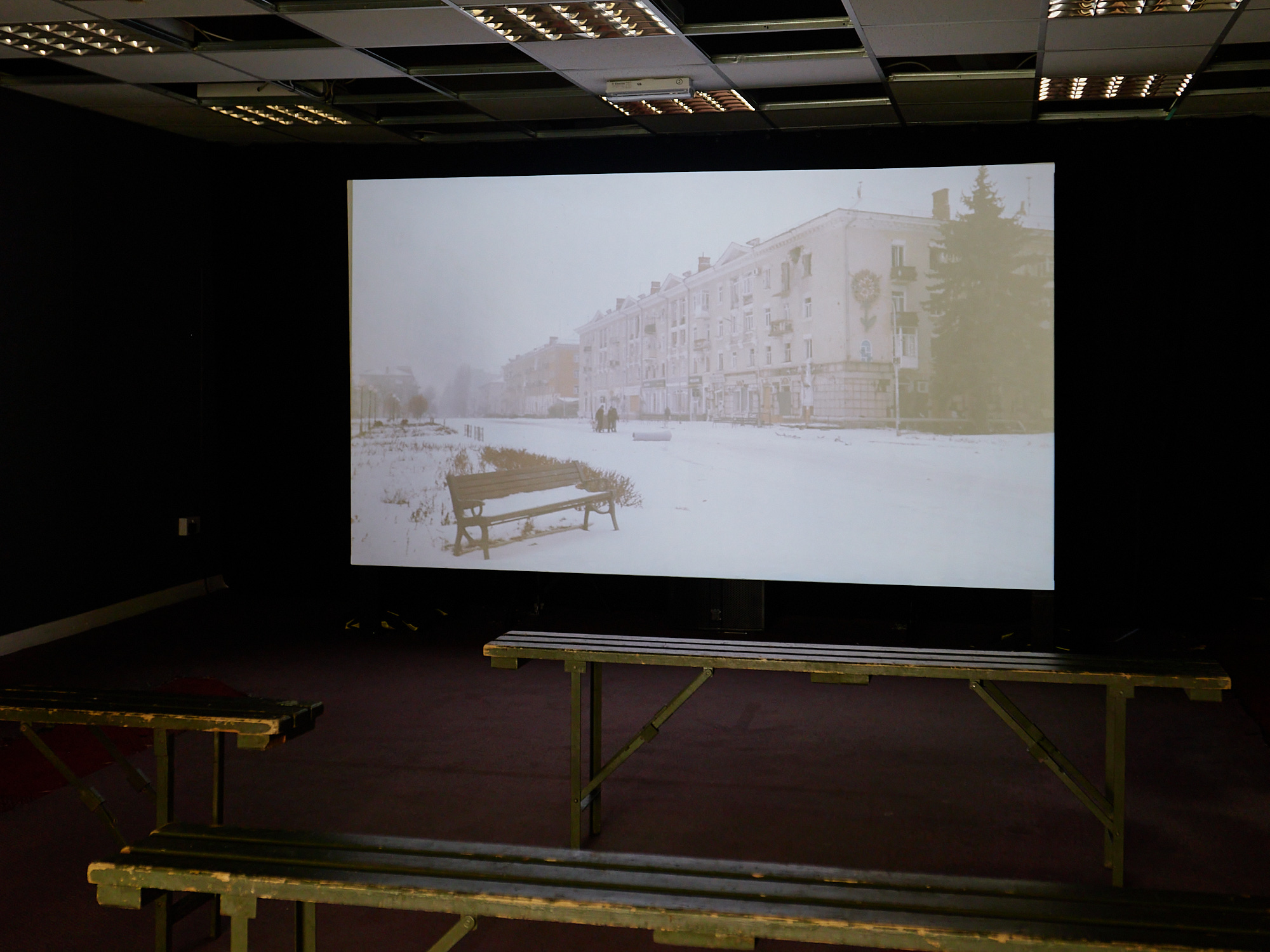
Alongside, And where now? is a film by Ukranian Svitlana Dovbush, a haunting and moving depiction of wartime landscapes in the eastern side of the artist’s country, damaged, ruptured, and reshaped by invasion and defence. It is not a documentary, so much as a poetic reflection. There are some connection between the two projects, but it seems that perhaps this is by accident more than curation – with no curatorial statement, title, or theme for the space, the visitor is left to draw their own conclusions, which may work for some, but in such a situation of presenting art in non-art spaces, and by virtue largely to a non-art audien
The Auxiliary Project is overseen by a small and highly energised team, led by Liam Slevin, Anna Byrne, and Edel O’Reilly, who also oversee an Art Week that is an extremely collaborative project involving several programme collaborators. As wide and complicated as Art Week is (including venues that had to change at the last moment for unforeseen circumstances) it’s small compared to their main project, a renovation and expansion of their Auxiliary HQ.
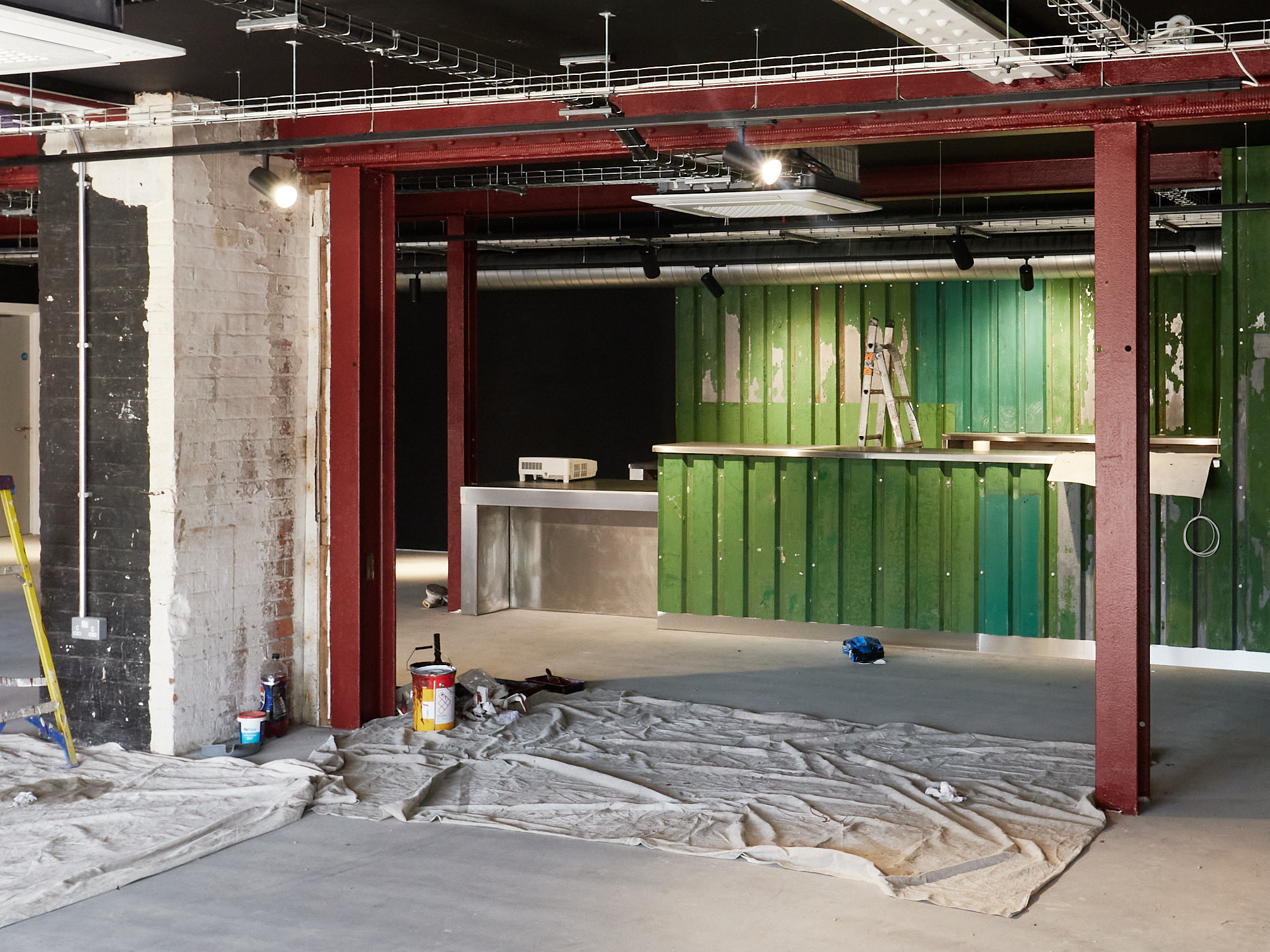

De Matos Ryan Architects were contracted for the job or making their much-loved but somewhat tired studio building suitable for makers to concentrate on their work in safety, with services, and without leaks or the cold. Their inventive approach, commonly used outside of the UK but less-so here, was to externally insulate the building, freeing up money and time for major internal rejigging. The new space offers a variety of 25 affordable studios which are now used for all kinds of craft from metalwork sculpting to painting. A new gallery space is opened up, an events space – incorporating a corrugated green material recognisable from the building’s previous life – offers a platform for non-visual arts as well as a for-hire opportunity to raise funds, while a newly inserted mezzanine offers loose space that as of yet has no function but surely will evolve to become central to the creative community.
It is exciting and hopefully offers Auxiliary a secure and strong base not only to support the region’s community of makers, but from which to plot and plan future Art Weeks. There is something fascinating about the alternative approaches of permanence and temporal culture, each landing and working with the local place in different ways. As the Auxiliary team surely know, it can be complicated and extremely tiring to operate in both modes, but ultimately reach different audiences in different ways.
Imagery supported by MPB - the right way to buy, trade and sell camera gear.
More information on MPB can be found here.
The Auxiliary Project Space is an artist-led,
National Portfolio Organisation based in Middlesbrough that emphasises artistic
development, large scale exhibitions, cultural development strategies and
community participation. While the organisation is active across middlesbrough
and teesside, its home is an 13,000sq ft warehouse, currently under capital
development supported by the DCMS Cultural Development Fund and Middlesbrough
Development Corporation. In addition to the provision of artists studios, workshops,
events and gallery spaces for local and international artists, The Auxiliary is
the creative engine powering two further cultural festivals each year; Sonic
Arts Week and Middlesbrough Art Week. A founding member of the Middlesbrough
Cultural Partnership and an advocate for the visual arts and festival sector,
The Auxiliary has been instrumental in transforming the region’s industrial
landscape into a hub for artistic and cultural innovation.
www.theauxiliary.co.uk
Middlesbrough Art Week was born in 2017 as an
artist-led festival powered by The Auxiliary Project Space, a growing team of
artists, curators and coordinators, and fuelled by wide reaching partnerships.
MAW supports artist ecologies in the North East, connecting artistic practice
and ideas with like-minded peers nationally and internationally, and is
committed to practise, and not just, preach principles of fair work and social
justice.
www.middlesbroughartweek.com
Lorem Ipsum is dolor sit amet, consectetur adipiscing elit. In aliquet elementum nulla, blandit tempor nunc. Phasellus ullamcorper lorem risus. Nulla in molestie dui.
www.url.com
www.middlesbroughartweek.com
Lorem Ipsum is dolor sit amet, consectetur adipiscing elit. In aliquet elementum nulla, blandit tempor nunc. Phasellus ullamcorper lorem risus. Nulla in molestie dui.
www.url.com
visit
The Auxillary Project in Middlesbrough will unveil their
events & exhibitions on their website: www.theauxiliary.co.uk
Keep an eye on the Middlesbrough Art Week website to find
out about plans for 2026 once they are revealed: www.middlesbroughartweek.com
images
All photographs
© Will Jennings.
Imagery supported by MPB - the right way to buy, trade and sell camera gear.
More information on MPB can be found here.
publication date
30 October 2025
tags
x
Keep an eye on the Middlesbrough Art Week website to find out about plans for 2026 once they are revealed: www.middlesbroughartweek.com


